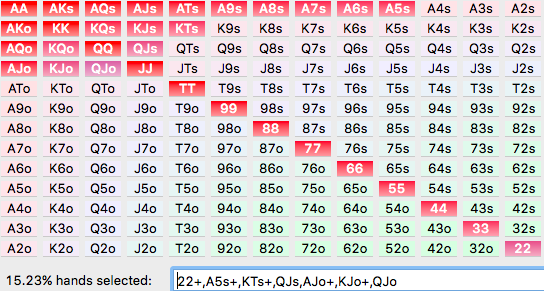Micro Sng Strategy
Single table tournaments (STTs), also known as sit and gos (SNGs), are the shortened variation of a multi table tournament (MTT). Despite the similarities in their names, these two games are very different from each other and require unique skill sets. The most basic difference is that a STT is generally quite short and will allow you to play many games at a time. Aside from the duration, other notable differences include payouts and blind structures.
Trying to play too tricky is one of the biggest downfalls for the majority of 6-max micro stakes players. Pre-Flop Strategy. The pre-flop strategy in 6-max games calls for a tight approach with a fair amount of aggression mixed in. While you don’t want to be playing in every single pot, sitting on the sidelines is going to do nothing more than allow your bankroll to bleed. 6-max games are where you can profitably. Strategy is to learn how to increase your levels of aggression. However, it must be done intelligently for it to be effective. The secret is to learn when to play aggressively and when to get out of the way. To get a free 11-minute video and 24-page PDF from me with tips.
- Double or Nothing Tournaments, also known as DON's, are a specific form of SNG poker tournaments. Instead of featuring payouts for the top places with the winner taking down close to half the total prize pool, these award a fixed payout to half the number of total entrants.
- Pokerstars Micro Sng Strategy have compiled a selection of the best online casinos for US players. This selection is based on promotions, bonuses, security, cash out options, reputation, software robustness, graphics, customer service, game diversity and the overall respect Pokerstars Micro Sng Strategy of the player. We update our top.
If you learn one of these games, you will have a better shot at succeeding in the other, but it will not be a walk in the park. There is a lot of variance associated with multi table tournaments, where that just isn’t the case for single table events. The trade off for reduced variance in STT games is a lower payout when you do cash.
In a SNG you will cash if you finish in the top 30% of the field. In a MTT, however, you will need to outlast 90% of the field, making it three times tougher to make the money. Both games have a lot of earning potential, but you should always remember that optimal strategy in one game will not match up with optimal strategy in the other game.
Players who stick to STT games will find that it is quite easy to effectively multi table without losing a whole lot of concentration or focus. For MTT players, on the other hand, this could not be further from the truth. The ever changing dynamics of multi table tournaments easily disallow players to really pay attention to what they are doing.
In a STT, the actions and plays are going to be relatively similar from one game to the next. Just like in cash games, the situations are not too unique and do not call for drastically different plays. As a result, an automated playing style will often work very well in STTs. There are a number of players who are able to beat both STT and MTT games, but they are certainly going to apply different strategies in each.
The key to beating any form of poker, though, is not necessarily your skill set but instead your consistency. The biggest STT and MTT players are able to perform at their best nearly all of the time. Short term variance can be tough to deal with in any tournament, but the most consistent players will always win out in the long run.
STT Strategy Overview

Single table tournament strategy is complex and almost never ending, but the general concepts are easy to learn and understand. The first thing to remember about STTs is that they are always an event where you should be playing to win. This should go without saying, but poker players tend to want to shoot for a cash instead of first place.
There is a thin line between going for the win and going for broke, though, so it is crucial that you play your cards just right. The time to put it all on the line will come much, much sooner in a STT than in a MTT. Your stack size is going to dwindle quickly as the blinds rise at a rapid pace. To adjust to these circumstances, a winning STT player needs to know when it is time to go all in and when it is time to fold.

Post flop strategy eventually goes out the window once the blinds increase a few levels into a STT. This differs from an MTT as multi table tournaments allow for a lot more actual “play” vs. gamble. The variance in STTs is derived from the push/fold strategy that needs to be adopted relatively on.
One of the biggest keys to winning in STTs is being able to make the right decisions without hesitation. Solid STT players almost instantly know whether any given hand is a shove or a fold when it comes down to the latter stages. If you don’t like the need to put all of your chips on the line in risky situations, you probably are not cut out for STTs.
Micro Sng Strategy Builder


MTT Strategy Overview
Multi table tournaments require a lot more strategy than STTs. There are a lot of blind level increases, table changes, and game flow changes that need to be accounted for in an MTT. You can be the chipleader at one of your tables, lose a big pot, and suddenly be shifted to a table where you are now the small stack.
The ability to quickly adjust to these constant changes is what will help to form a winning player. MTT strategy is all about the long term. You will absolutely need to get lucky, to one extent or another, if you ever hope to win an MTT. This is why the long term aspect is so very vital. You can go on a streak of five, 10, or even 20 games before you even min cash. Not even being able to min cash despite great play can be one of the most frustrating things in poker.
Micro Stakes Sng Strategy
MTT players need to have undying focus. MTTs are a marathon whereas SNGs are more like a sprint. If you aren’t prepared for the long haul, don’t expect to be killing MTTs any time soon. There is a fortune to be made in multi table tournaments if you have a lot of skill, a lot of persistance, and a little bit of luck.